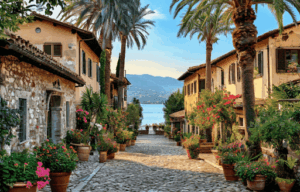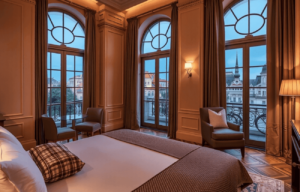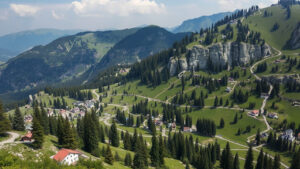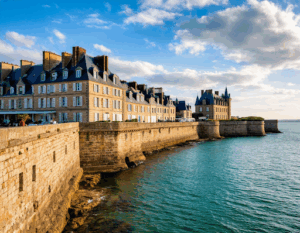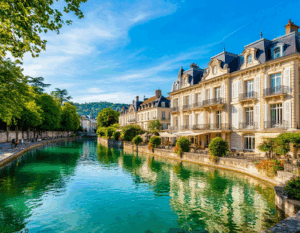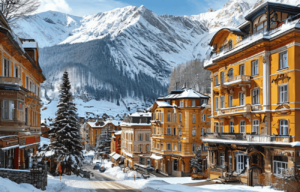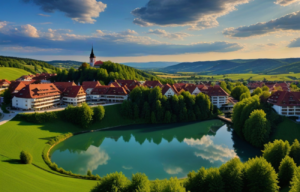Medical Wellness Treatment
How does medical wellness treatment work, and where is it truly effective?
In the context of chronic stress, a sedentary lifestyle, and constant strain, even relatively healthy people may experience sleep disturbances, digestive issues, blood pressure fluctuations, back pain, or flare-ups of chronic conditions. For those already diagnosed, symptoms often intensify seasonally or due to fatigue.
Medical wellness treatment is chosen by those who wish to prevent disease progression, improve their overall condition, and avoid hospitalization. It is not a vacation in the usual sense. It is a chance to undergo a course of therapy outside of a hospital setting — under comfortable conditions, under the supervision of specialists, and with access to natural therapeutic resources such as mineral waters, thermal springs, climate, therapeutic muds, and physiotherapy. This is complemented by a gentle diet, physical activity, and sleep restoration.
Medical wellness treatment helps to:
- Improve the condition in chronic diseases of the joints, heart, lungs, gastrointestinal tract, and nervous system
- Reduce the frequency and severity of seasonal flare-ups
- Recover after surgery, illness, injury, or COVID-19
- Enhance metabolic processes and reduce inflammation
- Decrease the pharmaceutical load, especially for patients with polypharmacy (the need to take many medications simultaneously)
- Build stress resilience and improve overall well-being
How Medical Wellness Treatment Works
Many facilities located at resort hotels operate fully licensed medical centers. These centers are staffed with qualified medical personnel and equipped with modern diagnostic and therapeutic technology. Doctors perform initial examinations, analyze medical records, and design personalized treatment programs based on the diagnosis, treatment goals, and individual tolerance of procedures.
A typical treatment course includes:
- Balneotherapy (baths, mineral water therapy, inhalations, irrigations)
- Physiotherapy and kinesiotherapy
- Dietary therapy
- Massage, thermotherapy, climatotherapy
- Continuous medical supervision throughout the program
Choosing a hotel at a resort is not only a matter of comfort — it’s about matching the resort’s natural healing factors with the patient’s medical profile. Some natural resources are effective for diabetes, others for gastritis or metabolic disorders, and others for liver or musculoskeletal conditions. Let’s look at how to select the right resort for your case.
Popular Resort Types
Thermal Resorts
ТThermal springs are natural water sources that emerge at the surface with elevated temperatures. These waters travel deep underground, becoming enriched with mineral salts, gases, and trace elements. When they surface, they retain both heat and their mineral composition. And it is this combination — temperature + chemical composition + hydrostatic pressure — that creates the therapeutic effect.
Thermal resorts (whether in Austria, Hungary, Turkey or Slovakia) are home to hotels with medical centers offering treatment programs specifically tailored to the properties of their local waters. Here, nothing is random — the composition of the water determines its indications.
Main types of thermal waters:
- Hydrogen Sulfide Waters
These waters contain dissolved hydrogen sulfide gas, known for its distinctive smell. In low therapeutic concentrations, hydrogen sulfide stimulates metabolic processes, improves circulation, provides pain relief, and promotes tissue healing. They are primarily used to treat skin conditions (such as psoriasis and eczema), joint and vascular disorders, and pelvic organ diseases. Hydrogen sulfide treatments are also commonly used for trophic disorders.
The most renowned hydrogen sulfide resorts are found in Italy and France.
- Radon Waters
Radon waters contain low concentrations of the radioactive noble gas radon. Upon contact with the skin, radon exerts a gentle analgesic, anti-inflammatory, and calming effect. It also influences metabolism and lowers cortisol levels (the stress hormone). Radon therapy is indicated for musculoskeletal disorders, nervous system conditions, gynecological problems, and certain endocrine and skin diseases.
Radon waters are especially common in the Czech Republic and Germany. One of Europe’s most famous radon resorts is Jachymov (Czech Republic), where radon baths have been successfully used for over 100 years.
- Carbonated Waters
Carbonated mineral waters are saturated with free carbon dioxide (CO₂). When immersed in these baths, CO₂ penetrates the body through the skin, boosting capillary blood flow, lowering blood pressure, and supporting heart function. These waters have a mild sedative effect, enhance physical endurance, and stimulate cellular respiration. Carbon dioxide baths are prescribed for cardiovascular diseases, hypertension, diabetes, circulatory disorders, and chronic fatigue syndrome.
Well-known carbonated water sources are found in the Czech Republic (Karlovy Vary), Slovakia, Austria, Germany, and Hungary.
What makes thermal water truly beneficial:
- Heat relaxes muscles, relieves spasms, and improves blood circulation
- Minerals absorb through the skin, reducing inflammation and supporting metabolism
- Immersion in water reduces joint load, eases movement, and supports lymphatic drainage
- Some springs contain sulfur, radon, or CO₂ — effective in treating dermatological, neurological, and joint conditions
- Regular treatments improve sleep, reduce anxiety, and strengthen immunity
Seaside Resorts
At seaside or oceanfront resorts, you can enjoy stunning beaches and fresh air — and also benefit from a unique environment for medical wellness treatment. Here, thalassotherapy is especially well developed: a treatment method based on marine resources such as seawater, algae, muds, salts, and climate. This approach is widely used along the coasts of France, Spain, and Italy.
Hotel-based programs include seawater baths, hydrotherapy showers, body wraps, inhalations, aerotherapy, and other physiotherapy procedures. As with thermal resorts, this approach is scientifically grounded — each marine water has a specific composition and thus its own therapeutic properties.
Benefits of coastal resorts:
- Seawater contains sodium, magnesium, iodine, calcium, and other elements that penetrate the skin and promote remineralization
- Humid air rich in ions supports the respiratory system and oxygenates tissues
- Algae wraps boost metabolism and help with circulatory issues
- Marine climate stabilize the nervous system, reduce stress, and normalize sleep
- Water supports the body, relieving pressure on the joints and spine
Thalassotherapy courses are recommended for skin conditions, bronchial asthma, chronic fatigue syndrome, thyroid disorders, and metabolic imbalances.
Some resorts offer a unique setting — thermal springs right by the sea. This combination allows for the integration of two powerful healing methods. You can find such complexes in Italy, Turkey, and Slovenia, where mineral springs emerge just steps from the coastline.
Spa and Wellness Resorts
Spa and wellness resorts focus on restoring the body’s resources and preventing disorders related to fatigue, stress, sedentary lifestyle, and irregular nutrition. This is a format of health-oriented vacation that combines modern methods of relaxation, physiotherapy, and lifestyle correction.
What wellness and spa retreats typically include:
- Hydrotherapy, aromatic and mineral baths
- Professional massages, stone therapy, Ayurvedic and Eastern techniques
- Detox programs, hormonal and energy balance restoration
- Yoga, meditation, breathing techniques, and body-oriented therapy
- Consultations with nutritionists and dietitians; development of a personalized diet
These resorts are especially recommended for those living in a high-paced environment, experiencing burnout, insomnia, or mood swings. Spa and wellness programs help you reset, restore internal resources, and build resilience to stress. They are also an effective way to maintain long-term health.
We work exclusively with trusted resorts and hotels that offer ideal conditions for full recovery. Guests can choose from a wide variety of health programs tailored to their goals, diagnoses, and personal preferences.
Top Countries for Medical Wellness Treatment
Choosing the right country for health-focused travel depends on several factors: climate, resort specialization, availability of natural healing resources, and quality of medical infrastructure. Below are destinations most trusted by our clients.
Italy
Italy has long been considered one of the best countries for medical wellness retreats. It offers a mild, comfortable climate, access to the sea, and rich natural resources.
One of Italy’s key advantages is its abundance of thermal springs — around 400 of them. Many are officially recognized as therapeutic and regulated by the Ministry of Health. Visitors come from around the world for prevention and treatment of chronic diseases, particularly conditions affecting the joints, spine, respiratory and nervous systems. Local waters rich in sulfur, magnesium, and calcium help reduce inflammation, boost metabolism, and strengthen immunity.
Italian resort hotels are renowned for their spa and wellness programs developed with medical expertise. These programs include therapeutic baths, mud treatments, inhalation therapy, massages, and physiotherapy. Many resorts focus specifically on recovery from chronic stress, improving sleep, and weight management. Thanks to the sunny climate and the country’s winemaking traditions, some regions even offer vinotherapy — treatments using grape and wine extracts. These stimulate microcirculation, improve skin condition, and slow the aging process.
Another major benefit of Italy is the opportunity to combine therapy with rich cultural experiences. After treatments, guests can stroll through the medieval towns of Tuscany, visit the Colosseum in Rome, enjoy the unique atmosphere of Venice, or admire the views of the Alps. Many also enjoy pairing their treatment with culinary journeys — visiting wineries and farmers’ markets, tasting local cheeses, olive oils, and traditional dishes. These emotionally enriching experiences are an essential part of recovery.
Spain
Spain is bordered by both the Mediterranean Sea and the Atlantic Ocean. Unsurprisingly, thalassotherapy has become the mainstay of local health resorts. Treatments with seawater help improve cardiovascular function, reduce swelling, tone skin and muscles, and speed up metabolism. The marine air further enhances these effects due to its high concentration of salts and ions. Spain’s mild climate, year-round sunshine, and abundant natural resources make it a perfect destination for recovery in any season.
Several regions — including Galicia, Castilla-La Mancha, Aragon, and Castile and León — are famous for their thermal springs. These balneological resorts utilize mineral-rich waters ideal for treating:
- Osteoarthritis
- Rheumatism
- Skin conditions
- Digestive disorders
- Metabolic imbalances
Many hotels and health complexes combine thermal treatments with spa and wellness services. Programs often include hydrotherapy, baths, body wraps, inhalations, nutritional support, and therapeutic exercise.
Germany
Germany is considered one of the most authoritative countries in the field of medical wellness. Here, balneology is not just a part of the wellness industry — it is a strictly regulated medical discipline.
There are more than 350 officially recognized resorts in Germany with mineral and thermal waters. Most have a clearly defined medical profile. Some specialize in musculoskeletal disorders, others in metabolic diseases, and others in neurological conditions.
German thermal waters maintain stable temperatures and high concentrations of natural gases — particularly carbon dioxide and hydrogen sulfide. These improve peripheral circulation, reduce inflammation, and promote tissue regeneration. Treatments often include CO₂ baths, underwater spinal traction, inhalation therapy, and mineral water intake.
Guests at German resorts can also enjoy modern spa programs. Wellness centers often employ specialists in functional medicine, nutrition, and psychotherapy.
Hungary
Hungary is home to around 60,000 mineral springs, more than 1,000 of which are thermal. Bathing is possible year-round — even in winter, water temperatures rarely fall below 26°C. Local waters are rich in sulfur, radon, magnesium, and bicarbonates. They are particularly effective for treating joint, spinal, and muscular conditions. For this reason, Hungarian health tourism places strong emphasis on musculoskeletal therapy.
Hungarian thermal resorts are also highly effective in treating skin conditions. Chronic forms of psoriasis, eczema, and seborrheic dermatitis respond especially well to therapy here.
Sulfur-rich mineral waters:
- Reduce skin inflammation
- Support tissue regeneration
- Relieve itching
- Prolong remission of chronic skin diseases
One of Hungary’s undeniable advantages is its relatively affordable pricing—significantly lower than in most Western European countries—while maintaining international standards of medical care. Remarkably, despite a population of just 10 million, Hungary welcomes over 40 million tourists annually.
Slovenia
Slovenia is one of the most environmentally friendly and safest countries in Europe. It ranks fifth in the world according to the Environmental Performance Index (EPI). It is an ideal destination for slow-paced wellness travel, active recovery, and holidays with children. The country offers a harmonious combination of mountains, Adriatic coastline, dense forests, caves, and mineral springs.
Thermal resorts, especially in the eastern part of Slovenia, specialize in post-injury rehabilitation and treatment of spinal and joint conditions. Most of the mineral waters here are mild in composition but highly effective when used as part of a therapeutic course.
One of Slovenia’s true natural treasures is Donat Mg mineral water from Rogaška Slatina, containing an exceptional 1040 mg of magnesium per liter. This water is beneficial for digestive disorders, irritable bowel syndrome, and stress-related conditions.
Czech Republic
The Czech Republic is rich in thermal springs, healing mud deposits, and natural carbon dioxide. Its most famous resorts — Karlovy Vary, Mariánské Lázně, and Františkovy Lázně — form the so-called Czech Golden Triangle of Health. Here, a medical consultation is mandatory before starting any treatments, ensuring each guest receives a fully personalized therapy plan.
The country hosts dozens of balneological resorts. Visitors come from all over the world to treat gastrointestinal disorders, liver and pancreas conditions, metabolic imbalances, and chronic fatigue. Drinking courses featuring unique mineral waters are particularly popular among guests with diabetes, gastritis, and obesity. Special attention is given to post-operative rehabilitation and recovery from chronic illnesses.
Thanks to its mild climate and lack of a distinct low season, Czech resorts welcome guests year-round. The charming medieval towns, historic architecture, and cultural heritage make the experience both therapeutic and enriching.
France
France’s wellness resorts are among the most prestigious and luxurious in Europe, catering to even the most discerning guests. The country’s greatest natural resource is its access to the sea and ocean, making thalassotherapy the primary focus of its wellness infrastructure. Treatments using seawater, mud, and algae are offered along the Mediterranean coast, the Atlantic, as well as in Normandy and Brittany.
France is also home to several thermal springs around which modern spa complexes have been built. The most famous of these is Vichy, one of Europe’s oldest and most prominent balneological destinations, included in the UNESCO World Heritage list. Vichy features 15 bicarbonate-sodium springs, 6 of which are used for therapeutic drinking.
Guests in France consistently note the exceptional level of service, wide variety of leisure options, and breathtaking scenery. After treatments, visitors can explore historical landmarks, museums, and exhibitions, or indulge in gourmet food and wine tours.
Austria
Austria offers ideal conditions for health and wellness: pure alpine air, thermal springs, scenic landscapes, and a calm, peaceful atmosphere. Most spa resorts are located near mountain lakes or in the foothills of the Alps, allowing guests to combine treatment with outdoor walks and physical activity.
Local thermal waters are known for their high content of sulfur, calcium, and magnesium. They are used to treat joint and spinal conditions, as well as to support recovery after surgery or injury. Medical wellness programs may include hydrotherapy, mud applications, kinesiotherapy, and exercise in thermal pools.
Wellness retreats in Austria are suitable not only for medical therapy but also for stress relief. Many resorts offer personalized wellness programs aimed at strengthening the immune system, supporting weight loss, and improving sleep. The alpine landscapes, pleasant climate, and serene environment enhance the healing effect.
Switzerland
Switzerland’s wellness resorts are renowned for their state-of-the-art medical facilities, pristine alpine air, and tranquil, secluded settings. There are no crowds — everything is designed for an individual approach and complete relaxation.
Thermal therapy is the main focus here. Hot mineral waters are used to treat chronic back pain, arthritis, metabolic disorders, and stress-related conditions. Medical complexes are equipped with the latest technology and staffed by physiotherapists, dietitians, and specialists in various fields.
Premium hotel spas offer a wide range of programs — from detox and anti-aging therapies to post-operative recovery. Treatments using alpine herbs, clay, and thermal salts are especially popular.
Wellness in Switzerland is not about mass tourism. It’s about healing in comfort, silence, and privacy. That’s why celebrities, politicians, and corporate executives choose it as a recovery destination.
Hospitality MedService works exclusively with trusted resorts, clinics, and hotels offering all the conditions necessary for high-quality therapeutic and wellness experiences. We will help you choose the best destination and program—based on your diagnosis, treatment goals, and personal preferences.
